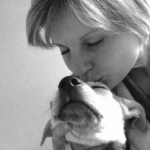The Healthy Diet
“You are what you eat” may be more than just a catchy phrase. The food we eat provides our bodies and our pets’ bodies with the building blocks necessary for the maintenance of health, for tissue repair and for energy. Expert agree that a wholesome diet, containing a wide diversity of macro and micro nutrients, is the key to good health. Most, if not all, commercially-available pet foods are highly processed, and may not be able to provide the full spectrum of nutrients essential for health and prevention of disease.
It is known that the processing of foods, for both human and pet foods alike, creates by-products that are pro-inflammatory and make insulin regulation more difficult, to mention two adverse aspects inherent in processed commercial pet food. These two negative effects from eating processed foods are a major cause for many diseases and degenerative health conditions.
The feeding of homemade diets and unprocessed foods can help to reverse the chronic effects of eating processed foods. When carbohydrates and protein in kibble and canned foods are heated at high temperatures, and are also exposed to high pressures, both which are associated with their manufacture, a chemical reaction occurs. This reaction is called the: “Maillard Reaction.”
As a result of this high heat and pressure reaction, the molecular structure of the food changes, into a “glycotoxin”, which is a toxic form of glucose (sugar). These new compounds created by food processing are called “Advanced Glycosylation End products”, or: “AGE’s”. These sugar-toxins contribute to aging and degenerative conditions in the body, including the adverse side effects of diabetes.
Problems with processed commercial foods pet foods include:
- Glycotoxins from high temperatures and pressures of pet food manufacturing
- Acrylamides which are toxins from food processing
- Pet food may be potentially carcinogenic based on presence of heterocyclic amines according to a study at the Lawrence Livermore Laboratory.
- Food storage mites can create a substantial impact on atopic dogs’ allergies.
- Reactive oxidative species (ROS), also known as free radicals, are created by food processing. Many degenerative conditions are the result of tissue damage secondary to free radicals’ impact on delicate living tissue.
- Chemical preservatives such as ethoxyquin may have an adverse effect on our pets with their long term use.
- Aflatoxins and other mycotoxins are commonly found on grains (especially corn and wheat) that have been stored for a while, which can be the case in the manufacture of commercial kibble. Aflatoxins are the leading cause of liver disease and liver cancer in the world today.
- Appropriate levels of essential or necessary nutrients may not be present in commercial diets.
- One example of this is the recent report of cardiomyopathy in Newfoundland dogs secondary to Taurine deficiency when fed a commercial dog kibble.
The problems listed above can only be eliminated by the feeding of minimally-processed pet foods. In the realm of commercial foods, the most minimally-processed forms of pet diets are the frozen raw diets, the cooked diets, the freeze-dried diets and the dehydrated diets. You can pretty much know that if it is a kibble or a canned diet, then they have used high temperatures and pressures to manufacture them, which, regardless of how good the label looks on the bag or can of food, its nutrient value has been diminished significantly by the processing. Unfortunately most commercially manufactured foods don’t contain high quality ingredients before they are processed. Adding a vitamin and mineral premix, or adding herbs or supplements to the diet in the small amounts that pet food companies use, contribute almost nothing to the nutrient value of the diet as a whole.
The best diet that we can eat, and its just the same for our four legged friends, is a wholesome, made from scratch diet with a wide variety of different nutrient sources, minimally processed, with additional fresh oils such as flax seed oil or meal and fish oil, as well as probiotics, and nutrient herbs such as alfalfa, nettles, nutritional yeast, and lecithin, to name few of the wholesome ingredients found in a healthy home prepared meal. Home made diets don’t have to be raw to be good, they just need to be cooked at normal low kitchen temperatures, such as are good for human diets as well.
Home prepared diets for companion animals can also provide benefits to companion animals in addition to improved nutritional intake. There is so much talk these days about the “Human-Animal Bond”, and how pets influence our health as much as we influence their health. Preparing food at home for one’s pet is one of the most bonding experiences you can imagine. For patients with terminal diseases, this is an opportunity for the pet’s guardian to minister to their beloved critter in their last days, weeks, or months on earth.
Home prepared foods are tastier than most commercial diets, so they are naturally more palatable. Many pets with chronic or terminal diseases will become fussier about their diets. Many times its not the brand or the meat type that is in the commercially processed kibble, but it is the processed kibble itself that these animals will not eat. Switching them to a homemade diet can have very positive effects.
For pets with allergies, sometimes a home made diet is the only way to provide a pet with a hypoallergenic dietary choice. Studies of food allergies have found that kibble can be allergenic due to the processing associated with its manufacture, which changes its molecular structure. With some pets who have multiple problems, there may not be a commercially available diet that covers all their diseases, so a home-prepared meal may be better able to address all of its issues in a single diet.
Home made diets are not for everyone. Some people are unable to prepare meals for themselves. How then can they prepare food for their pets? For some people a better choice than making it themselves would be to use the frozen raw or cooked diets that are complete and balanced that can be bought at the pet store. These are the least processed of all the commercially available foods in the marketplace.
If you want to provide your pet with a better quality of nutrition, but don’t have the time every day to prepare the meals yourself at home, you may want to think about “compromise diets”. These can be a good option when you don’t have enough time to prepare a well-balanced home-prepared meal yourself. In a compromise diet, you start with a healthy kibble or canned ration, and then add healthy leftovers. There is a special way to do this so as to not over-feed your dog, but instead to provide them with some healthy wholesome food. This approach will be detailed in future articles under this category. Adding nutritional supplements and herbs to further increase the nutritional content of your pet’s diet isn’t the same as wholesome food, but can be very helpful to fortify the minimal nutrition found in commercial kibble and canned foods.
The articles that follow this introductory article will provide details on all of these different diets that you can feed your pets for their health’s sake. Your questions and comments are welcome. VIEW ALL DIET POSTS




